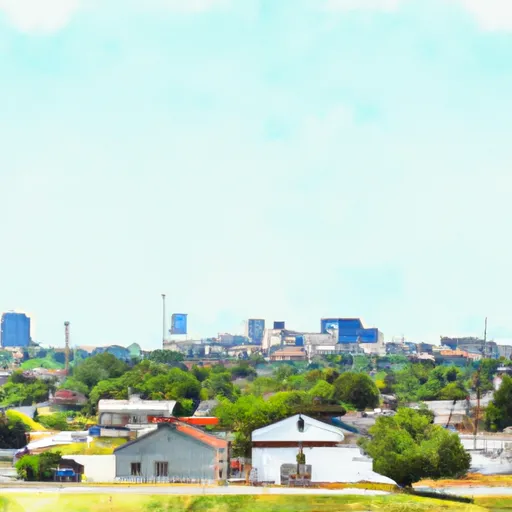-
 Snoflo Premium
Snoflo Premium
Get unlimited access to all our content
With no Ad interruptions! - Start Your Free Trial Login with existing account
Whitewright
Eden Index
Climate
9.8
•
Recreation
2.2
•
Community
2.7
•
Safeguard
5.4/10

Whitewright, Texas is a charming small town located in Grayson County. It enjoys a humid subtropical climate, characterized by hot summers and mild winters. The average high temperature in the summer months hovers around 95°F (35°C), while winter temperatures typically range from 30°F to 60°F (-1°C to 15°C).
As for hydrology constituents, Whitewright is situated near several bodies of water. The nearby Bois d'Arc Lake, one of the largest reservoirs in North Texas, offers ample opportunities for fishing, boating, and water sports. Additionally, the Red River, which forms part of the Texas-Oklahoma border, provides another outlet for outdoor enthusiasts interested in activities such as kayaking and birdwatching.
The town itself boasts a number of outdoor recreation opportunities. The Whitewright Municipal Park offers facilities for picnicking, walking trails, and sports fields for activities like soccer and baseball. There are also several public parks and green spaces where residents and visitors can enjoy nature and outdoor gatherings.
Overall, Whitewright, Texas offers a pleasant climate, access to various water bodies, and a range of outdoor recreation opportunities, making it an appealing destination for nature lovers and outdoor enthusiasts alike.
What is the Eden Index?
The Snoflo Eden Index serves as a comprehensive rating system for regions, evaluating their desirability through a holistic assessment of climate health, outdoor recreation opportunities, and natural disaster risk, acknowledging the profound impact of these factors on livability and well-being.
Climate Health Indicator (CHI): 9.8
Whitewright receives approximately
1077mm of rain per year,
with humidity levels near 75%
and air temperatures averaging around
18°C.
Whitewright has a plant hardyness factor of
7, meaning
plants and agriculture in this region tend to thrive during the non-winter months.
By considering the ideal temperature range, reliable water supplies, clean air, and stable seasonal rain or snowpacks, the Climate Health Indicator (CHI) underscores the significance of a healthy climate as the foundation for quality living.
A healthy climate is paramount for ensuring a high quality of life and livability in a region, fostering both physical well-being and environmental harmony. This can be characterized by ideal temperatures, reliable access to water supplies, clean air, and consistent seasonal rain or snowpacks.
Weather Forecast
Streamflow Conditions
Red-Little
Area Rivers
Red-Little
Snowpack Depths
Red-Little
Reservoir Storage Capacity
Red-Little
Groundwater Levels
Recreational Opportunity Index (ROI): 2.2
The Recreational Opportunity Index (ROI) recognizes the value of outdoor recreational options, such as parks, hiking trails, camping sites, and fishing spots, while acknowledging that climate plays a pivotal role in ensuring the comfort and consistency of these experiences.
Access to outdoor recreational opportunities, encompassing activities such as parks, hiking, camping, and fishing, is crucial for overall well-being, and the climate plays a pivotal role in enabling and enhancing these experiences, ensuring that individuals can engage in nature-based activities comfortably and consistently.
Camping Areas
| Campground | Campsites | Reservations | Toilets | Showers | Elevation |
|---|---|---|---|---|---|
| Fort Parker State Park | 25 | 449 ft | |||
| East Burns Run - Lake Texoma | None | 661 ft | |||
| Dam Site | None | 560 ft | |||
| Lake Mexia Rec Area | 22 | 471 ft | |||
| Alberta Creek - Lake Texoma | None | 678 ft | |||
| Lakeside - Lake Texoma | None | 632 ft | |||
| West Burns Run - Lake Texoma | None | 632 ft | |||
| Platter Flats - Lake Texoma | None | 646 ft | |||
| Willafa Woods - Lake Texoma | None | 634 ft | |||
| Willow Springs - Lake Texoma | None | 647 ft |
Nearby Fishing
Catastrophe Safeguard Index (CSI):
The Catastrophe Safeguard Index (CSI) recognizes that natural disaster risk, encompassing floods, fires, hurricanes, and tornadoes, can drastically affect safety and the overall appeal of an area.
The level of natural disaster risk in a region significantly affects safety and the overall livability, with climate change amplifying these risks by potentially increasing the frequency and intensity of events like floods, fires, hurricanes, and tornadoes, thereby posing substantial challenges to community resilience and well-being.
Community Resilience Indicator (CRI): 2.7
The Community Resilience Indicator (CRI) recognizes that education, healthcare, and socioeconomics are crucial to the well-being of a region. The CRI acknowledges the profound impact of these elements on residents' overall quality of life. By evaluating educational resources, healthcare accessibility, and economic inclusivity, the index captures the essential aspects that contribute to a thriving community, fostering resident satisfaction, equity, and social cohesion.

